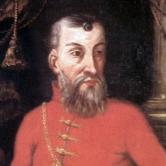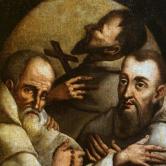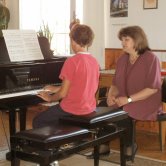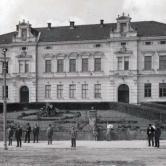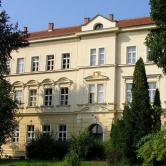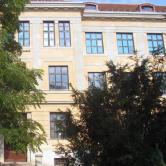Culture and tradition > Education System
Paulines are a catholic order named “the White Friars” after their white robes. They were institutionalized under Bartholomew, the Bishop of Pečuh / Pécs, around 1215. Essential for the beginning of educational and cultural activities of the Pauline order was the Pauline monastery in Lepoglava, established in 1400 by Herman of Celje on his estate. The order was abolished in 1786 by Joseph II, and the Church of St Ana became the Parish church. The abolition of the Pauline and Franciscan Order had negative consequences for the city, since it also meant that the Pauline gymnasium would stop functioning. Pauline author, Tituš Brezovački, who owned a house in Križevci, initiated the action to re-establish the Order in 1802. In early July 1790 in Križevci, Brezovački wrote one of his early poems denouncing Hungarization, titled Dalmatiae, Croatiae et Slavoniae trium recursus ad novum proregem Comitem Joannen Erdödy (The three sisters, Dalmatia, Croatia and Slavonia plead with the new banus Ivan Erdödy).
For more than 120 years, the Pauline monks taught classes in the gymnasium, elementary school and German school. Upon finishing the gymnasium, students were able to continue their education at the Jesuit colleges in Zagreb. The monks had a big influence on the town’s culture and youth literacy, and they also educated children from the neighbouring areas.
Music School Albert Štriga
Organized music education in Križevci began in the early 19th century. From 1813 until mid-19th century there was the Institute of Music, where individual students had an opportunity to receive music education (organ playing, playing some of wind instruments, singing). In the period from 1860s until 1880s, there was an independent Music Classroom within the Main School. Later, music education was not provided in the Music School. The Music School was opened on 4th September 1945 and it was situated in the Croatian House, its present-day location.
It was founded on January 1, 1970, as an autonomous music school and was named Primary Music School Albert Štriga, after Alberto Ognjan Štriga , an opera singer from Križevci, who was also the founder of the first Illyrian Music Association. The School was situated within the building of Croatian House. Starting from 1970 the School had a central place in local music scene. The Music School was attended by students of local primary and secondary schools, as well as by some students from schools outside Križevci. The School was awarded bronze and golden plaque by the Municipality of Križevc, whereas the school orchestra playing a traditional Croatian string instrument tamburica was awarded a Golden Palque by the Town of Križevci in 1994.
The school orchestra playing a traditional Croatian string instrument tamburica was awarded numerous Golden Palques at the Pajo Kolarić Festival of Tamburica held in Osijek, as well as several awards at international festivals abroad. During the course of the academic year 1994-95 a Secondary School Department was established, so there were two Departments within Music School Albert Štriga, those of elementary and secondary music programs.
Primary School Ljudevit Modec
Public education in Križevci can be traced to 1665, when Ivan Zakmardi of Dijankovec founded the Pauline Monastery. At first, the Pauline Gymnasium comprised only four grades, but later on it offered remedial courses in reading, writing, and maths. A written Approval allowing the Pauline Order to re-establish education, which was issued on December 4, 1674, and signed by Ferdinand Ersten, a fortress commander, provides a written record of the beginnings of public education.
The education system Ratio educationis publicae was established in 1777, while in 1784 the Gymnasium and the Pauline Order were abolished. German was recognized as the official language, and was taught in schools, and used in official communication. The first public school was opened in 1779, and the classes were taught at pupils’ homes and it the Town Hall. It comprised four grades, while the final year was the preparatory year for Gymnasium and the curriculum included Latin classes.
In some documents dating from 1829 music rooms are mentioned, while during the course of the academic year 1839-40, remedial courses, which provided "higher remedial education", were offered. In 1855 a new school building was completed, and in 1856 a library was added. In 1869, following constant requests by local teachers, the town authorities approved the opening of a four-grade School for Girls.
In 1875 the school was officially named the "Public Primary School", followed by the first teacher symposium attended by teachers from Križevci and Koprivnica, a year later. On July 25, 1900, the local authorities approved the construction of a new school building. The school was completed on September 9, 1901, and has been functioning ever since.
Following World War II "Public Primary School" comprised seven grades and it became a practice site for pre-service teachers enrolled into the Primary School Teacher Training College. In 1957 the school became an independent educational institution known as the second primary school of Križevci. In 1969 it was named "Bratstvo i jedinstvo (Brotherhood and Unity)", only to be re-named in 1991 to Primary School Ljudevit Modec, after the famous local educator and writer. The Branch Schools which are administered by Primary School Ljudevit Modec include regional schools in Apatovec, Dubovec, Poljana Križevačk, St Helena, Veliki Raven, Vojakovački Kloštar, and Vojakovec.
Primary School "Vladimir Nazor"
The first written record of public school in Križevci dates back to 1664, when the Pauline Monastery was founded. As stated in the document, The Pauline Monastery is allowed "...to re-establish primary education...". The first independent primary school started functioning in 1779, when an agreement was made between the town authorities and the Prior of the Monastery, according to which the Franciscan Monastery would be the patron of two teachers, and the Pauline Monastery of one. Josip Ferbarić was appointed headmaster.
"Public Primary School" comprised four grades, while the final year was the preparatory year for Gymnasium. The Pauline Monastery was abolished in 1786, and the first teachers who didn’t come from the ranks of priests, like Mato Raus and Franjo Radičević, were appointed. Their salary was 200 forints, and their rent was also covered. As the number of pupils increased, the town authorities appointed a schoolmistress in 1794, and allocated a classroom for girls. Mato Raus’s wife taught the class for 50 forints. In 1797 the school was named "The Main Primary School", and in 1856 the school moved into a new building, and later that same year a library was established. In 1857 a school garden was created.
The school established a collection of teaching devices and school equipment. In 1873 the school participated in the world exhibition in Vienna, and on July 28, 1875 it celebrated its 200th anniversary. New school building was opened on September 1, 1924. In 1984, due to the lack of space, a new building was constructed.
Kvirin Vidačić, famous for his account of the history of the town and the school, as well as for his work " Historical and Topographical Account of the Free Royal Town of Križevci", was the headmaster of the school from 1861 until 1888, when he was retired. He also published some articles related to education in the first magazine dealing exclusively with education in Croatia called "Progress".
Special Education and Rehabilitation Center
Education of children with special education needs started in 1970, in primary school "Vladimir Nazor". In 1975, the school Department of Special Education moved into a new building located at Nemčić Square. In 1980 the Department relocated to the attic and basement rooms, which was completely unappropriate.
In 1998 Marija Prodan, the head of the Department of Special Education, together with other rehabilitators and special educators, initiated construction of the new building for children with special education needs. The building was completed in 2001, and the School for Children with Special Education Needs started functioning in 2002. On July 22, 2005, Koprivnica-Križevci County Assembly allowed the establishment of the Special Education and Rehabilitation Center 2005.
Special Education and Rehabilitation Center offers preschool and primary school education for children with developmental difficulties. Preschool offers education to children aged between 3 and 7 years old, while Primary School offers primary education for children aged 7-21. Occupational Therapy Service provides help for people over 21 according to their mental abilities.


